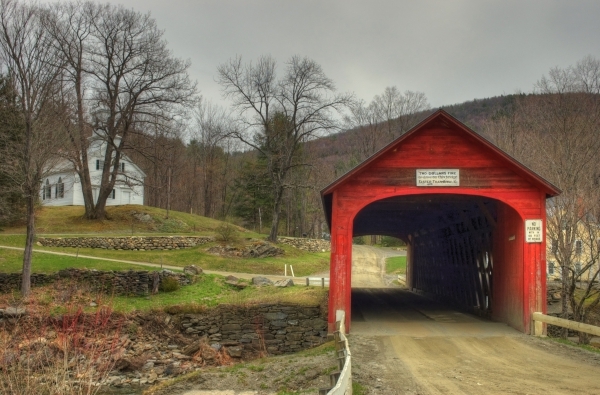GUILFORD — The end of the road is still far away from inside the Green River Covered Bridge project.
The 1830 bridge on Jacksonville Stage Road will receive an anticipated $550,000 of repairs this coming summer to update its load from 4 to 8 tons if several key pieces fall into place.
The live load rating for the bridge was lowered in June 2014 after failing to meet regulations for its marked rating.
A critical point for keeping the live load rating at 8 tons or greater is the ability for emergency vehicles to cross safely.
In a report by Hoyle, Tanner & Associates, commissioned by the Selectboard after the bridge was downgraded, “The Green River Covered Bridge does not meet the Town of Guilford's needs for an unposted river crossing without height restrictions and currently requires a long detour: approximately 14 miles to the north, or 19 miles to the south for vehicles weighing greater than four tons and/or greater than 11 feet 6 inches in height, depending on which route is taken.”
The report explored a number of alternatives for crossing the river within 0.5 mile of the bridge.
In November, the Selectboard voted to expand the scope of the repairs that had already been planned for the historic bridge.
The work will include replacing the asphalt shingle roof with a standing seam metal roof, removing distribution beams, and interchanging the existing decks with a 2.5-inch Douglas fir deck with 1.5” white oak running boards.
The bottom chord of the truss will be supplemented where it had received previous repairs.
The design plan will be completed by Hoyle, Tanner, & Associates.
The town has $315,000 set aside for the project and will use a combination of grant money and bonding to raise the additional $235,000.
Up to $50,000 will be disbursed for the design work.
The town will apply for a grant from the state Agency of Transportation's Town Highway Structures program, to be awarded in the spring.
The program provides 80 percent of the cost of an approved bridge, culvert, and retaining wall projects within a municipality's highway infrastructure, according to the AOT's “Orange Book,” a handbook for local governments. The agency will fund up to 90 percent if a town has adopted certain state design standards.
The town has been informed by a district representative from the agency that the bridge is a high priority for the state agency, but cannot guarantee funding.
If all else fails, the town will make up the difference with bonding and borrowing. Town Administrator Becky Stone and Selectboard member Anne Rider have both agreed, “We'll cross that bridge when we get to it.”
The town must complete repairs to the bridge this summer when school is not in session. Guilford will also have to pursue temporary easement grants with residents whose property borders the bridge.
This step will be challenging in light of a recent discovery that the land under the road is not owned by the town - and that no one knows yet who owns it.
The bridge, built by Marcus Worden, a Guilford resident, is 104 feet long and features spruce beams pinned by oak pegs. The design of the bridge, Town's lattice truss, is named for its inventor, Ithiel Town.
“Unlike other timber bridge trusses used at that time, Town's design depended on lap joints secured with treenails rather than precision mortising,” notes Bridgehunter.com, a website devoted to historic bridges. “This decreased the dependency on high-skill labor and decreased construction time.”
